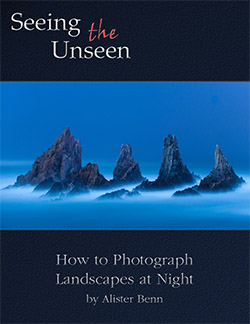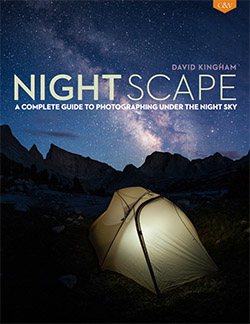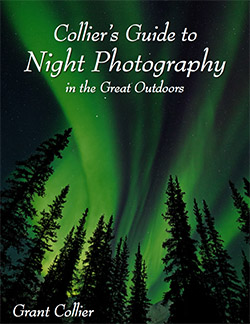Three How-to Landscape Night Photography Books reviewed
No Comments
The history of night photography stretches back to the early 20th century, all the way to Alfred Stiegliz. However, it is only in the last decade that, ignited by advances in digital cameras, natural landscapes (as opposed to man-made structures) have become a popular subject for night photography. Making a natural landscape photograph that captures at the same time the beauty of the night sky requires much knowledge, and more careful planning and technique than daytime photography.
The three books reviewed in this article aim to teach all of this to you. I can recommend each of them without reservation. Despite the inevitable overlap, there are singular elements in each of the books, and each author has a distinctively different approach.
They are not for photography beginners, as they assume you can shoot in manual mode with a DSLR or mirrorless camera, and that you are familiar with post-processing software such as Lightroom or Photoshop. Despite being tightly focussed, skipping the basics, and skipping photography of man-made environments, they are still substantial books with no fluff. There is much to learn there!
Seeing the Unseen: How to Photograph Landscapes at Night by Alister Benn

When published in March 2012, it was the reference book about its subject, covering a vast range of topics from preparation to field techniques and exposure, both single and multiple.
Alister Benn takes a somehow philosophical approach to photography, which is reflected in the book – and the choice of Guy Tal for the foreword. He tries to avoid getting bogged down in too technical considerations, which makes the book friendly for beginners. Besides the foundational knowledge and techniques of night photography, Seeing the Unseen touches on visualization and composition, but doesn’t dwell much on gear or processing. Subjects covered range from relatively basic and strongly worded advice (such as the useful high ISO test shot) to more advanced considerations such as the rarely discussed use of GNDs filters at night or how to orient yourself to find the kind of star motion you are after.
Recognizing that photography starts with light, Benn uses the different types of light available at night as a guiding framework for much of the book. He starts by categorizing those types as different parts of the night and of the lunar month, and proceeds later by explaining how to evaluate and then capture scenes in each type of light. Although some readers might find that this mode of presentation a bit disjoint and redundant, it does make sense. Besides the technical data, each of the inspiring images – made in many locations around the world – also identifies the type of light under which it was created.
I noticed an emphasis on the moon and its phases, as well as the blue hour. Benn advises to shoot in the evenings for the first weeks of the lunar month (new moon to full moon) and at predawn for the last two weeks, resulting in images that are fairly bright. As the title indicates, this is a book which deals substantially with capturing the terrestrial landscape.
Seeing the Unseen: How to Photograph Landscapes at Night is a 96-page ebook with about 24,000 words, designed like a traditional book (facing vertical pages) but with many pages consisting of relatively short paragraphs. It is available both as a PDF on the author’s site ($15) or as a Kindle book on Amazon ($8) – which doesn’t provide high resolution images unlike the PDF.
Nightscape: A Complete Guide to Photographing Under the Night Sky by David Kingsham

David Kingsham made his mark as a photographer of the night sky. Those two words are fittingly included in the subtitle of the book. It distinguishes itself by its sensitivity and attention to capturing the beauty of the starry night sky (a style sometimes referred to as “astro-landscape photography” when little moonlight is present. Within that focus, the treatment is deep and full of useful tips.
Recognizing that preparation is key, Nightscape (2014) starts with two excellent section on understanding the night sky and its variations. I read for the first time about “airglow” there. Post-processing is strongly covered, with the book featuring the most detailed exposition I’ve seen anywhere of how to process photos in Lightroom (a set of LR presets are provided by download) so that they depict accurately the colors of the night sky, including colors of the stars.
Although the tone makes it very accessible and appealing to the photographer with no night photography experience, Nightscape touches advanced multiple image techniques, which the author acknowledges were necessary for nearly all images in the book. Their coverage is rather brief, but all the essential ideas are there and many links are provided. The book ends with a complete step-by-step tutorial on creating some of the most tricky night images: meteor showers with multiple meteors composited. This very specialized section appears a bit out of place compared with the rest of the book, which is a relatively light read, especially since it relies on Photoshop, which is not used elsewhere. However it gives the reader a good taste of the complexity of some images and the work behind them.
As part of the excellent Craft and Vision offerings, Nightscape: A Complete Guide to Photographing Under the Night Sky emphasizes craft over gear, however it does mention all the useful specialized equipment, even the fog filter. Like the other C&V titles, it is an affordable ($12) PDF with horizontal pages designed to look particularly attractive on the computer screen, with legible typography and large, beautiful photographs (with technical data but nothing else) resulting in 120 pages, although the word count is also about 24,000.
Collier’s Guide to Night Photography in the Great Outdoors by Grant Collier

Although Collier’s Guide to Night Photography is the most recent (2015) book about this subject, Grant Collier is a long-time practitioner of the genre, with 12 years of night photography experience, starting in the film days. I’ve long admired his Arches National Park work, in which night views reveal a new vision of familiar scenes, so I was pleased that Grant sent me a review copy of his guide to night photography.
Collier’s Guide to Night Photography at the same time covers more topics and goes into more depth than other books on the same subjects. As a night photographer with some experience, it was clear to me that the advice and tips in the book come from the numerous hours spent in the field. It is the night photography book from which I have learned the most. I wish it was available when I started. Despite the amount of advanced material, the night photography beginner will also benefit from the book thanks to the clear, concise, and no-nonsense writing.
Some of the most impressive photographs by Collier are his unique multiple-image panoramas. It is a technique he perfected to overcome the technical limitations of early digital cameras. The two previous books have made the case for why multiple image techniques can help realize one’s vision of creating images that can’t be achieved with a single shot. However, only Collier’s book goes into detail about how to blend and stitch images together – maybe the most intriguing material the book for advanced photographers, together with light painting and star trails. The last chapter goes beyond Lightroom in detailing Photoshop techniques. As those take a lot of explaining, more can be found in a companion video offering.
Another difference with the previous books is that Collier goes beyond the generic, not hesitating to discusses specific gear by brand and model, such as lenses, various lights for light painting, and equatorial mounts. He also list specific resources, such as weather, star, aurora websites and apps.
The images used to illustrate the techniques are very varied and all superb. Besides the expected technical data, they are presented with a brief, but informative technical comment about the main challenge they posed, making them suitable for learning by example.
Collier’s Guide to Night Photography in the Great Outdoors is published both as an ebook ($18.95) and a paperback. ($29.95). Because of that, the design is that of a traditional book, with dense paragraphs: the book has more words (75,000 words) than its 160 pages would suggest. That’s what makes it possible to be so comprehensive and detailed.
Did you read any of those books ? Are there others that you would recommend ?

